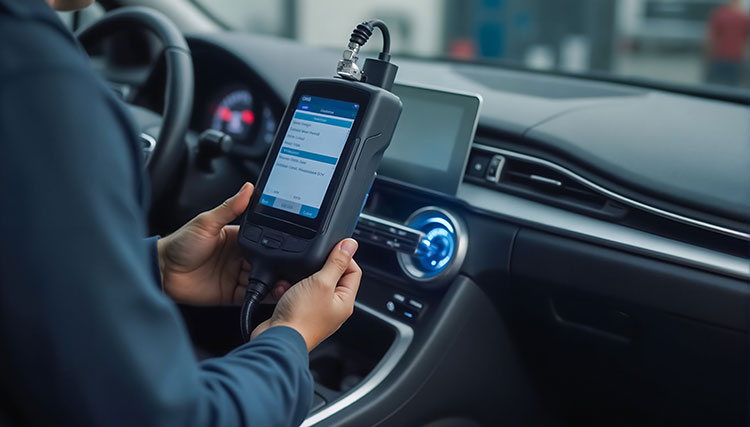|
That small amber icon shaped like an engine might not seem urgent—but it’s one of the most important signals your vehicle can give you. Whether it lights up after a cold start or suddenly appears during a drive, the check engine light (CEL) is your vehicle’s built-in warning system alerting you to potential problems—some minor, others serious. Ignoring it can lead to reduced fuel efficiency, costly damage, or even safety issues down the road. In this article, we break down exactly what the check engine light means, why prompt diagnostics matter, and how dealership-level tools go far beyond the basics to protect your vehicle and your wallet.
What the Check Engine Light Really Means
The check engine light, formally called the Malfunction Indicator Lamp (MIL), is part of your vehicle’s OBD-II (onboard diagnostics) system. When illuminated, it means the computer has detected a problem affecting emissions, performance, or drivability. A steady light typically means a non-urgent issue like a sensor fault, while a flashing light warns of a more severe problem, such as a misfire that could damage the catalytic converter.
Common causes include:
- Loose or damaged fuel cap: This allows fuel vapours to escape, triggering an emissions fault.
- Oxygen sensor failure: This sensor monitors air-fuel mixture and adjusts fuel delivery. A bad sensor reduces fuel efficiency and can harm the catalytic converter.
- Faulty spark plugs or ignition coils: These cause engine misfires, rough idling, and poor acceleration. Continued driving may damage exhaust components.
- Catalytic converter issues: A vital emissions system part that, when damaged, is expensive to replace—often over $1,200.
Why Prompt Diagnostics Matter
Delaying diagnosis can turn a minor issue into a major repair. For example, a misfire that isn’t corrected in time can overheat and damage the catalytic converter. A faulty sensor left unchecked may cause the vehicle to run rich or lean, damaging the engine or reducing fuel economy.
Quick diagnostics also improve efficiency. When a technician identifies a fault early, repairs are typically faster, less expensive, and avoid unexpected breakdowns. Even if your vehicle seems to be running fine, the check engine light may still indicate a problem that’s silently affecting emissions or internal components.

The Power of Dealer-Grade Scan Tools
While many drivers can purchase a basic OBD-II scanner online or from a parts store, there’s a big difference between consumer-grade tools and the equipment found at a professional service centre.
Dealer-level scan tools offer:
- OEM-specific codes: Consumer scanners often only read generic codes. Dealer tools interpret manufacturer-specific data, revealing more accurate and actionable information.
- Live data monitoring: Technicians can view real-time performance data like fuel trims, oxygen sensor voltages, engine timing, and more to diagnose subtle issues.
- Full module access: Beyond the engine, dealer scanners can communicate with ABS, transmission, airbag, and other systems that a basic scanner may ignore.
- Built-in system tests: These tools allow technicians to run actuator tests, reset system adaptations, and perform component calibrations.
This level of access not only speeds up repairs but also ensures that no problems are missed.
What Happens During a Diagnostic Appointment
When you bring your vehicle in for a check engine light diagnosis, here’s what typically happens:
- Initial scan: The technician retrieves trouble codes stored in the vehicle’s computer. These may include current faults and historical (pending) issues.
- Live data analysis: The technician reviews real-time sensor values to look for abnormalities—this helps confirm whether a component is actually failing or if the issue is intermittent.
- System testing: In some cases, components like ignition coils, fuel injectors, or EVAP valves are tested directly using bidirectional controls from the scanner.
- Repair verification: Once repairs are made, the technician clears the codes and road tests the vehicle. If the light stays off and all system monitors reset correctly, the problem is resolved.
When to Drive and When to Stop
- If the check engine light is steady and there are no obvious performance issues, it’s usually safe to drive short distances. However, it’s important to schedule service soon to prevent long-term problems.
- If the light is flashing, or you notice loss of power, strange smells, or abnormal engine noise, stop driving immediately. A flashing check engine light indicates active engine damage—typically a misfire that can overheat the catalytic converter.
Empowering You with the Right Information
While Bluetooth OBD-II tools can offer a quick snapshot of an issue, they don’t tell the full story. DIY scans are fine for curiosity or early troubleshooting, but for accurate repairs, professional tools and trained technicians are essential.
Why Choose a Dealership Service Department?
Our service centre uses the same tools, software, and diagnostic strategies used by the vehicle’s manufacturer. We can interpret complex codes and conditions more accurately and perform repairs with full access to OEM service bulletins, calibration data, and technical expertise.
Our diagnostic appointments include:
- Full multi-module scan using OEM scan tools
- Live performance data analysis
- Verification of all fault conditions
- Accurate repairs and post-repair validation
The check engine light isn’t something to ignore or reset blindly. It’s your vehicle’s early warning system—meant to keep you safe, protect critical components, and maintain peak performance. Fast, professional diagnostics can save you time, money, and frustration.
Click the button below to book your service appointment and let our team handle your check engine light with the care and precision your vehicle deserves.
|